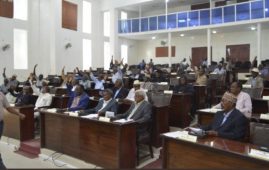United Nations’ Economic Commission for Africa (ECA) has published it’s 2014 MDG Report 2014: “Assessing Progress in Africa toward the Millennium Development Goals: Analysis of the Common African Position on the post-2015 Development Agenda”.
The report provides insight on how to measure the performance of the continent in achieving the Millennium Development Goals (MDGs) and the historical context that we should take into account.
Read below extracts from the document.
Africa’s progress towards achieving the MDGs is gaining momentum, and the continent continues to make steady progress on most of the goals including primary school enrolment, gender parity in primary school enrolment, the proportion of seats held by women in national parliament, and reversing HIV/AIDS prevalence, incidence and death rates. Indeed, in some cases, Africa’s performance exceeds some regions such as South- East Asia, Latin America and the Caribbean, and Western Asia. This is both remarkable and commendable given the starting point of most African countries.
Notwithstanding these achievements, the continent is considered off-track on most of the MDGs targets. This view is based on an assessment methodology that only tracks the level of performance on an indicator in relation to the 2015 target for that indicator. A typical illustration of this way is as follows: the proportion of people living on less than US$1.25 a day in Southern, East, Central and West Africa as a group decreased from 56.5 percent in 1990 to 48.5 percent in 2010. As a result, the region is approximately 20.25 percentage points off the 2015 target compared to 4.1 for South Asia; hence, the target will not likely be met should current trends continue….
….It is interesting to note, however, that all MDG performance assessments that measure distance away from the starting point find that African countries are among the top performers towards achieving the MDGs. Indeed, these methodologies yield strikingly different results than the traditional method of measuring progress, which is based exclusively on distance from the target.
Africa’s current performance on the MDGs cannot be separated from its initial conditions. The continent’s experience illustrates the challenges that regions or countries at low levels of development face in making progress on the MDGs and the importance of taking into account of such constraints in assessments of their MDG performance. As the final year of the MDGs approaches, it is important not to lose sight of the historical context that framed the continent’s MDG performance.
After almost two decades of low growth, since the early 1990s, Africa has witnessed remarkable real GDP growth (around 5 percent), driven by rising commodity prices, stable macro-economic stability and good governance. The positive performance was buoyed by a decline in the incidence of conflict and growing domestic investments, particularly in infrastructure …
…… The continent’s recent economic performance was preceded by what has been dubbed ‘the lost decade’. Indeed, the lackluster performance led the Economist magazine to describe Africa as the “hopeless continent” in May 2000. It was not until 2011 that the same magazine referred to Africa as the “rising continent”. This was followed by a March 2013 special report of the magazine, which referred to Africa as the “hopeful continent”. The period prior to the growth acceleration in Africa was characterized by low per capita incomes and lackluster real GDP growth.
Indeed, the continent’s per capita incomes levels began to diverge from the other regions after 1980, a period that coincided with the adoption of Structural Adjustment Programmes in Africa. By curtailing the role of the state in economic activities and opening up Africa’s nascent economies to competition from more mature economies, Structural Adjustment Programmes not only undermined the delivery of social services, but also contributed to low growth, de-industrialization and heightened dependence on primary commodities.
Real GDP growth averaged 1.32 percent during the 1980-1989 period, and by 1990, per capita incomes in Africa were almost half of the level in Asia and a quarter of the level in Latin America.
Africa’s performance on the MDGs has also been constrained by limited access to financing. ODA and concessional lending have contributed to expanding the fiscal envelope, but at the same time, conditionalities and tied aid have closed the policy space for several African countries to implement bold policies and initiatives. Furthermore, the volume of aid has fallen short of commitments. Although ODA to Africa reached unprecedented levels in 2006, it was still well below the 0.7 percent of GNI commitments made by Development Assistance Committee (DAC) members.
……….. In the backdrop of these initial conditions, it is therefore not surprising that, by the MDG benchmark year of 1990, Africa excluding North Africa had the worst performance on all the MDG indicators, with the exception of the following indicators: prevalence of underweight children under five years of age; gender parity in primary enrolment; the share of women in wage employment in the non-agricultural sector; and a few obvious environment indicators, such as the proportion of land area covered by forests; the proportion of terrestrial and marine areas protected; and carbon dioxide emissions. Indeed, the positive performance on the environmental indicators is a reflection of the low level of development of the continent.
…The implications of this assessment methodology are far-reaching, i.e. countries such as Ethiopia, Uganda and Mozambique are expected to achieve the same targets as countries with much lower poverty rates. But more importantly, the low level of development and growth in most developing countries in Africa suggests that they had to overcome a higher level of development ‘inertia’ than countries that enjoyed more sophisticated infrastructure a more productive workforce and well established institutions.
******





